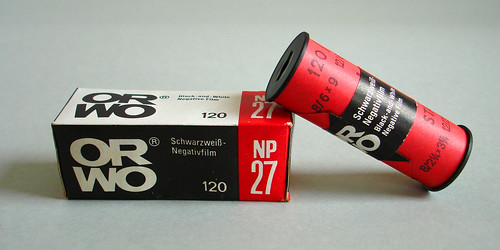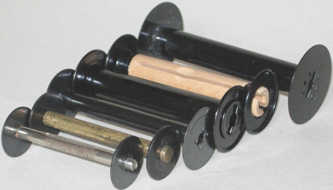Rollfilm
A first rollfilm device was patented in 1854 by J. B. Spencer and A. J. Melhuish. It used "sheets of calotype paper gummed together and wound on rollers" [Coe]. In 1875 L. Warnecke got a patent on his "roller slide" for a more successful rollfilm variant, a paper roll with light sensitive dry collodion surface for 100 exposures. The rollholder was made well, but the film material was not. In 1884 William H. Walker and George Eastman developed a rollholder attachable to standard plate cameras. In 1885 they could present a new improved paper negative film which was called the "American Film". The light sensitive layer of that film was made of gelatine. After development the film was soaked with warm water so that the gelatine layer could be stripped from the paper strip and transfered onto glass plates or another transparent base. That way the gelatine layer became a transparent negative. Thus the print quality could be improved. That kind of film together with a Walker-Eastman rollholder was used for the Eastman Detective Camera developed by Eastman and F. M. Cossitt in 1886. A small number of these complicated cameras was made until 1888. The Kodak Camera of 1888 was the most successful camera for "American Film", despite of the inconvenience that the whole camera had to be sent to the factory in Rochester when the film was exposed. There the film was developed, prints were made, and the camera was reloaded with a new 100 exposure film roll. The success of this camera was the base on which rollfilm box cameras stayed popular until the 1950s.
In 1888 Eastman engaged Henry M. Reichenbach to find a transparent substitute for the paper base of the rollfilm. He found celluloid (cellulose nitrate) of which flexible transparent foils could be made. Contemporary film makers had already used celluloid plates as replacement for glass plates. The foil got coated with gelatine film emulsion.
In 1891 a daylight loading version of roll film was offered by Kodak, the roll enclosed in a carton, with paper ends to have the film enwrapped light-tight when loading or unloading. The modern paper backed roll film was introduced with the Boston Camera Manufacturing Company's No. 2 Bulls-Eye box camera which was the first that had a red window as exposure counting facility for such film. Kodak bought the company so as not to be obliged to pay a license fee for the red window. The most popular roll film format type No. 120 was introduced with Kodak's Brownie No. 2 in 1901. Other popular rollfilm formats were type No. 620 and 127.

|
| type No. 120 film roll and carton - once called cartridge film because the film roll was resembling a shotgun cartridge |

|
| Roll film spools: 127, E29, 620, 120 (metal), 120 (wood), 116 |
Sources
- Coe, Brian: The Birth Of Photography, 1976